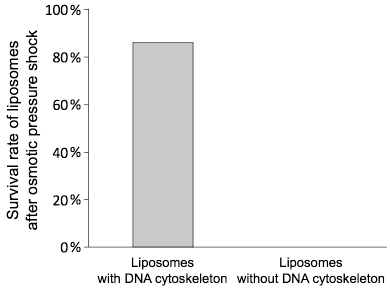A research group from Tokyo University of Agriculture and Technology, Tokyo Institute of Technology, Keio University and Tohoku University has successfully developed an artificial cytoskeletal structure for cell models (liposomes1 or artificial cells) using DNA nanotechnology.2 And in doing so, has demonstrated that liposomes using this frame are almost as strong as living cells.
Liposomes have been used as a material in many common products such as capsules for drug delivery and cosmetics. But the membrane is fragile, so the liposomes are prone to collapse with only slight stimulus, causing the contents to leak. To improve their function, a method has been needed to toughen the liposomes and control their strength.
Using DNA nanotechnology, researchers from Tokyo University of Agriculture and Tokyo Institute of Technology have developed a network structure of DNA that supports membranes similar to a cytoskeleton in living cells(Figure 1A). The DNA strands used in the study bind to each other and create a network structure by decreasing the temperature (Figure 1B). And since DNA has a negative electric charge, using the attractive force between DNA and the inner layer of liposome with a positive charge, scientists were able to form a DNA cytoskeleton that provided structural support for the liposome membrane.

Figure 1: Schematic illustration of the experiment. (A) An illustration of the cross section of a liposome with DNA skeletal structure. (B) Schematic diagram showing the DNA network formation.
Liposomes are generally easy to collapse even when a slight osmotic pressure is applied. However, in the experiments, liposomes using the newly developed DNA cytoskeleton were tolerant of an osmotic pressure - even when the applied osmotic pressure was comparable to that applied by the human body (Figure 2).

Figure 2: Survival rates of liposomes after osmotic pressure shock when the osmotic pressure is applied to liposomes with the DNA skeleton (left) and without it (right).
This reinforcement function is derived from the network structure of DNA. An additional advantage is that the strength of the DNA cytoskeleton can be controlled by the DNA base sequence design. Because the artificial cytoskeleton is formed using DNA, it is expected to have various functions such as using DNA chemical reactions to induce membrane collapse for the controlled release of encapsulated compounds.
The results of this research were published in the online version of Proceedings of the National Academy of Sciences of the United States of America on June 26, 2017.
Technical terms
- 1) Liposome: An artificial lipid bilayer membrane vesicle mainly composed of lipids. It is used in various fields such as cell membrane modelling, drug delivery, and cosmetics.
- 2) DNA nanotechnology: A technology to create nanometer-sized (1/1,000,000th of a millimeter) structures in a controlled manner by utilizing the nature of double helix formation of DNA. In this study, the network structure created by DNA was produced and utilized for the construction of an artificial cytoskeleton.
- Publication Details:
Title: DNA cytoskeleton for stabilizing artificial cells
Authors: Chikako Kurokawa, Kei Fujiwara, Masamune Morita, Ibuki Kawamata, Yui Kawagishi, Atsushi Sakai, Yoshihiro Murayama, Shin-ichiro M. Nomura, Satoshi Murata, Masahiro Takinoue, Miho Yanagisawa
Journal: Proceedings of the National Academy of Sciences of the United States of America
DOI: 10.1073/pnas.1702208114
For enquiries about this research:
Miho YanagisawaDivision of Advanced Applied Physics, Institute of Engineering,
Tokyo University of Agriculture and Technology
E-mail : myanagi@cc.tuat.ac.jp
Tel:81-42-388-7113
Masahiro Takinoue
Department of Computer Science, School of Computing,
Tokyo Institute of Technology
E-mail : takinoue@c.titech.ac.jp
Tel: 81-45-924-5654
Kei Fujiwara
Department of Biosciences and Informatics,
Faculty of Science and Technology,
Keio University
E-mail : fujiwara@bio.keio.ac.jp
Tel: 81-45-566-1533
Satoshi Murata
Department of Robotics,
Graduate School of Engineering,
Tohoku University
E-mail: murata@molbot.mech.tohoku.ac.jp
Tel: +81-22-795-4100
Press contact:
Division of Public RelationsSchool of Engineering,
Tohoku University
Email:eng-pr@grp.tohoku.ac.jp

